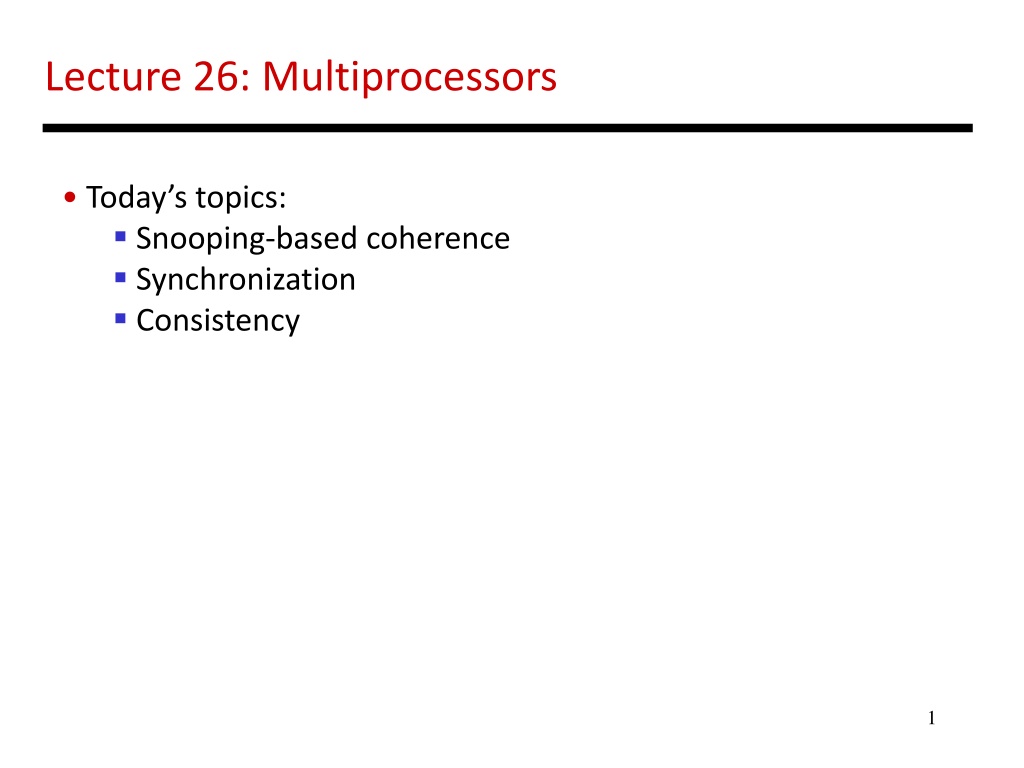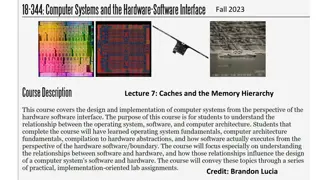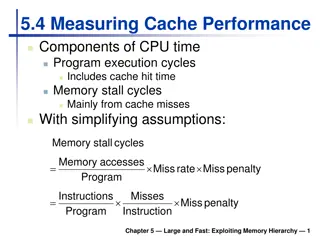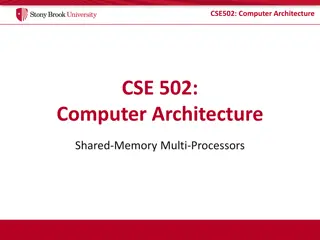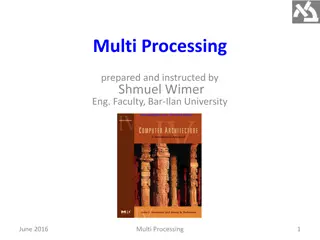Understanding Multiprocessors and Memory Hierarchy
Explore topics such as snooping-based coherence, synchronization, consistency, virtual memory overview, address translation, memory hierarchy properties, TLB functionality, TLB and cache access considerations, and cache indexing strategies in multiprocessor systems.
Download Presentation

Please find below an Image/Link to download the presentation.
The content on the website is provided AS IS for your information and personal use only. It may not be sold, licensed, or shared on other websites without obtaining consent from the author. Download presentation by click this link. If you encounter any issues during the download, it is possible that the publisher has removed the file from their server.
E N D
Presentation Transcript
Lecture 26: Multiprocessors Today s topics: Snooping-based coherence Synchronization Consistency 1
Address Translation The virtual and physical memory are broken up into pages 8KB page size Virtual address 13 virtual page number page offset Translated to physical page number Physical address 3
Memory Hierarchy Properties A virtual memory page can be placed anywhere in physical memory (fully-associative) Replacement is usually LRU (since the miss penalty is huge, we can invest some effort to minimize misses) A page table (indexed by virtual page number) is used for translating virtual to physical page number The page table is itself in memory 4
TLB Since the number of pages is very high, the page table capacity is too large to fit on chip A translation lookaside buffer (TLB) caches the virtual to physical page number translation for recent accesses A TLB miss requires us to access the page table, which may not even be found in the cache two expensive memory look-ups to access one word of data! A large page size can increase the coverage of the TLB and reduce the capacity of the page table, but also increases memory waste 5
TLB and Cache Is the cache indexed with virtual or physical address? To index with a physical address, we will have to first look up the TLB, then the cache longer access time Multiple virtual addresses can map to the same physical address must ensure that these different virtual addresses will map to the same location in cache else, there will be two different copies of the same physical memory word Does the tag array store virtual or physical addresses? Since multiple virtual addresses can map to the same physical address, a virtual tag comparison can flag a miss even if the correct physical memory word is present 7
Cache and TLB Pipeline Virtual address Offset Virtual index Virtual page number TLB Tag array Data array Physical page number Physical tag Physical tag comparion Virtually Indexed; Physically Tagged Cache 8
Bad Events Consider the longest latency possible for a load instruction: TLB miss: must look up page table to find translation for v.page P Calculate the virtual memory address for the page table entry that has the translation for page P let s say, this is v.page Q TLB miss for v.page Q: will require navigation of a hierarchical page table (let s ignore this case for now and assume we have succeeded in finding the physical memory location (R) for page Q) Access memory location R (find this either in L1, L2, or memory) We now have the translation for v.page P put this into the TLB We now have a TLB hit and know the physical page number this allows us to do tag comparison and check the L1 cache for a hit If there s a miss in L1, check L2 if that misses, check in memory At any point, if the page table entry claims that the page is on disk, flag a page fault the OS then copies the page from disk to memory and the hardware resumes what it was doing before the page fault phew! 9
Multiprocessor Taxonomy SISD: single instruction and single data stream: uniprocessor MISD: no commercial multiprocessor: imagine data going through a pipeline of execution engines SIMD: vector architectures: lower flexibility MIMD: most multiprocessors today: easy to construct with off-the-shelf computers, most flexibility 10
Memory Organization - I Centralized shared-memory multiprocessor or Symmetric shared-memory multiprocessor (SMP) Multiple processors connected to a single centralized memory since all processors see the same memory organization uniform memory access (UMA) Shared-memory because all processors can access the entire memory address space Can centralized memory emerge as a bandwidth bottleneck? not if you have large caches and employ fewer than a dozen processors 11
Snooping-Based Protocols Three states for a block: invalid, shared, modified A write is placed on the bus and sharers invalidate themselves The protocols are referred to as MSI, MESI, etc. Processor Processor Processor Processor Caches Caches Caches Caches Main Memory I/O System 12
Example P1 reads X: not found in cache-1, request sent on bus, memory responds, X is placed in cache-1 in shared state P2 reads X: not found in cache-2, request sent on bus, everyone snoops this request, cache-1does nothing because this is just a read request, memory responds, X is placed in cache-2 in shared state P1 writes X: cache-1 has data in shared state (shared only provides read perms), request sent on bus, cache-2 snoops and then invalidates its copy of X, cache-1 moves its state to modified P2 reads X: cache-2 has data in invalid state, request sent on bus, cache-1 snoops and realizes it has the only valid copy, so it downgrades itself to shared state and responds with data, X is placed in cache-2 in shared state, memory is also updated P1 P2 Cache-1 Cache-2 Main Memory 13
Example Request Cache Hit/Miss Request on the bus Who responds State in Cache 1 State in Cache 2 State in Cache 3 State in Cache 4 Inv Inv Inv Inv P1: Rd X Rd Miss Rd X Memory S Inv Inv Inv P2: Rd X Rd Miss Rd X Memory S S Inv Inv P2: Wr X Perms Miss Upgrade X No response. Other caches invalidate. Inv M Inv Inv P3: Wr X Wr Miss Wr X P2 responds Inv Inv M Inv P3: Rd X Rd Hit - - Inv Inv M Inv P4: Rd X Rd Miss Rd X P3 responds. Mem wrtbk Inv Inv S S 14
Cache Coherence Protocols Directory-based: A single location (directory) keeps track of the sharing status of a block of memory Snooping: Every cache block is accompanied by the sharing status of that block all cache controllers monitor the shared bus so they can update the sharing status of the block, if necessary Write-invalidate: a processor gains exclusive access of a block before writing by invalidating all other copies Write-update: when a processor writes, it updates other shared copies of that block 15
Constructing Locks Applications have phases (consisting of many instructions) that must be executed atomically, without other parallel processes modifying the data A lock surrounding the data/code ensures that only one program can be in a critical section at a time The hardware must provide some basic primitives that allow us to construct locks with different properties Bank balance $1000 Parallel (unlocked) banking transactions Rd $1000 Add $100 Wr $1100 Rd $1000 Add $200 Wr $1200 16
Synchronization The simplest hardware primitive that greatly facilitates synchronization implementations (locks, barriers, etc.) is an atomic read-modify-write Atomic exchange: swap contents of register and memory Special case of atomic exchange: test & set: transfer memory location into register and write 1 into memory (if memory has 0, lock is free) When multiple parallel threads execute this code, only one will be able to enter CS lock: t&s register, location bnz register, lock CS st location, #0 17
Coherence Vs. Consistency Coherence guarantees (i) write propagation (a write will eventually be seen by other processors), and (ii) write serialization (all processors see writes to the same location in the same order) The consistency model defines the ordering of writes and reads to different memory locations the hardware guarantees a certain consistency model and the programmer attempts to write correct programs with those assumptions 18
Consistency Example Consider a multiprocessor with bus-based snooping cache coherence Initially A = B = 0 P1 P2 A 1 B 1 if (B == 0) if (A == 0) Crit.Section Crit.Section 19
Consistency Example Consider a multiprocessor with bus-based snooping cache coherence Initially A = B = 0 P1 P2 A 1 B 1 if (B == 0) if (A == 0) Crit.Section Crit.Section The programmer expected the above code to implement a lock because of ooo, both processors can enter the critical section The consistency model lets the programmer know what assumptions they can make about the hardware s reordering capabilities 20
Sequential Consistency A multiprocessor is sequentially consistent if the result of the execution is achieveable by maintaining program order within a processor and interleaving accesses by different processors in an arbitrary fashion The multiprocessor in the previous example is not sequentially consistent Can implement sequential consistency by requiring the following: program order, write serialization, everyone has seen an update before a value is read very intuitive for the programmer, but extremely slow 21
Relaxed Consistency Sequential consistency is very slow The programming complications/surprises are caused when the program has race conditions (two threads dealing with same data and at least one of the threads is modifying the data) If programmers are disciplined and enforce mutual exclusion when dealing with shared data, we can allow some re-orderings and higher performance This is effective at balancing performance & programming effort 22
